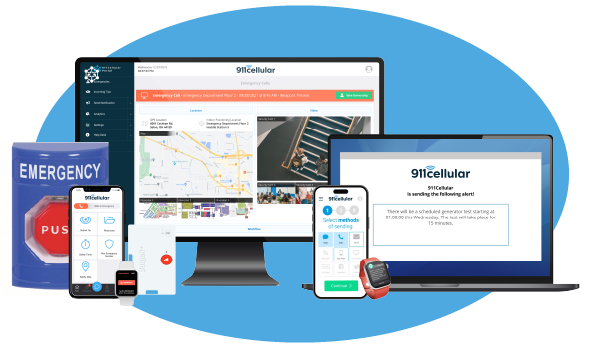Workplace violence prevention: 5 things to do today
Workplace violence has become a major issue for many businesses and healthcare systems in the U.S. for decades. According to the Occupational Safety and Health Administration (OSHA), almost 2 million U.S. workers report having been a victim of violence at work each year. This number is even more staggering when you consider that about 3 out of every 4 workplace violence incidents occur in the healthcare or social services industries.
According to the Bureau of Labor Statistics, 20,790 workers in the private industry experienced trauma from nonfatal workplace violence in 2018. Of these workers, over 70% were female and 20% required a month or longer away from work to recover.
These jarring statistics should alone provide enough motivation for employers to commit to a non-violent workplace environment, but the data even shows that there are significant financial consequences of persistent workplace violence as well. In healthcare for instance, over 58 incidents occur annually per 10,000 workers with an average cost per incident of over $3,000. This means that annually, per 10,000 workers, healthcare systems are losing nearly $200,000.
Despite all this negativity, there are many things that your organization can do today to help prevent workplace violence incidents from occurring regularly.
1. Identify workplace violence types
There are 4 main types of workplace violence that can be categorized depending on the perpetrator’s relationship to the victim and/or place of employment. Understanding these types can be crucial for identifying potential patterns or risk levels at your particular workplace, thereby allowing you to take efficient action to protect against further incidents. The 4 types are as follows:
Criminal intent
The perpetrator has no legitimate business relationship to the workplace and usually enters the affected workplace to commit a robbery or other criminal act.
Prevention strategy for this type: cash control, lighting control, entry and exit control, surveillance, signage, training on robbery response, training on dealing with aggressive and disorderly persons.
Customer/client
The perpetrator is either the recipient or the object of a service provided by the affected workplace or the victim. The assailant may be a current or former client, patient, customer, passenger, criminal suspect, inmate, or prisoner.
Prevention strategy for this type: Adequate staffing and training (low quality service can result in frustrated customers or clients), training to recognize behavioural cues, violence de-escalation techniques, interpersonal communication skills and proper restraint/take-down techniques.
Co-worker
The perpetrator has some employment-related involvement with the affected workplace. Usually this involves an assault by a current or former employee, supervisor or manager.
Prevention strategy for this type: Maintain a thorough hiring process (conduct criminal background screens and check former employee references), train employees regularly on company policies and how/when to report signs of workplace violence.
Personal relationship
The perpetrator is someone who does not work there but has or is known to have had a personal relationship with an employee.
Prevention strategy for this type: Training employees to identify victims or perpetrators of intimate partner violence (IPV), maintain a culture of support (no penalties for coming forward, confidentiality, safety and security protocols implemented, community service referrals offered).
2. Create a plan for reducing workplace violence
As a rule of thumb, your organization should always have an updated Emergency Action Plan (EAP) in place. Communicating this plan to employees and other community members is also vital. But not every organization elects to include workplace violence prevention into their EAP. Some organizations may feel that they don’t need it because workplace violence is not common in their industry. This can be risky, as it increases liability and probability of an incident occurring.
If your organization has an EAP in place, check to see if it includes workplace violence prevention. If not, suggest that changes be made to include this oversight (or begin planning for changes yourself if you are able to).
Remember that after an EAP is created, it’s imperative that staff members are trained on how to respond to certain scenarios and what their specific roles and responsibilities might be during these critical situations.
3. Assess potential threats
A threat assessment team is a committee of employees from various levels and expertise within an organization whose role is to assess the seriousness and likelihood of a threat after it has been recognized. Employers may need to seek outside talent to assist in workplace violence prevention, intervention and risk management. The goal of the threat assessment team should be to review non-emergency incident reports and recommend appropriate action.
To help prevent co-worker violence in the workplace, the following are some examples of questions that can be asked to individuals familiar with an offender after threatening comments or behaviour has occurred:
- How does the offender cope with disappointment, loss or failure?
- Does the offender blame others for their failures?
- Does the offender indicate they are being treated unfairly by the company?
- Does the offender have problems with supervisors or management?
- Does the offender speak of personal problems such as divorce, death in the family, health problems, or other personal losses or issues?
- Is the offender obsessed with others or engaged in any stalking or surveillance activity?
- Has the offender spoken about homicide or suicide?
4. Encourage reporting
It’s vital that employers are doing everything they can to encourage their employees to report their concerns regarding workplace violence. Employees need to feel secure in their positions and confident that their reports will be taken seriously. Also, it’s important that employee reporting of such incidents remains confidential and there are methods in place for submitting such reports that are conducive to this.
Proper training of newer employees is a good way to start, though reminders should be given at specific times to all employees about reporting procedures and policies, even when there are no updates. It’s always better to encourage over-reporting than running the risk of having someone not report something that ends up being costly in the long run.
5. Proactive prevention

Preventing workplace violence happens in many phases, it can be an easier pill to swallow if we consider the angle of just ‘finding the bad person’ and swooping in to prevent them from doing anything. This, however, can be an oversimplification of this complicated issue. It’s important for employers to provide a variety of supportive resources to employees before they get the chance to become agitated or disapprove of supervisor behavior.
For example, providing comprehensive mental health resources to employees will likely give them confidence that their employer’s priorities are on point, and that employees are encouraged to express themselves in a non-threatening environment.
It’s also important that employees feel that they are heard at work as well, even if they’re not reporting a workplace violence incident or sign. It’s far more likely that an employee will report a workplace violence indicator if they already trust the employer for providing them additional resources at other times as well.
Reversing the trend
Workplace violence is no longer a secret, but unfortunately that doesn’t mean the trend has reversed course for the better quite yet. Incidents are still under-reported in many industries and it can even be seen as ‘part of the job’ for some nurses and healthcare workers. This devastating reality has to stop, and it’s up to each of us to play our part in the fight against violence in the workplace.
Learn more about workplace violence prevention solutions.
Tags: Healthcare safety Computer panic buttons Workplace violence







